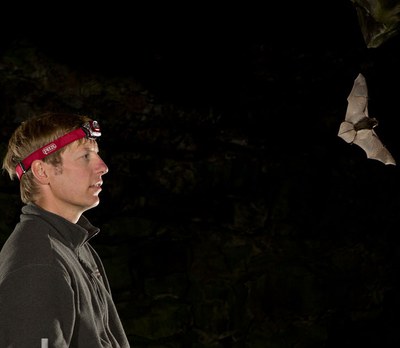Thanks to those of you who came out to our February 28 Nature Night, The Beauty of Bats! It was an educational presentation full of fascinating information and incredible visuals from ecologist Tom Rodhouse and photographer Michael Durham.
Here are some interesting takeaways from their talk.
Cool facts about bats:
- There are over 1,000 species of bats that are incredibly diverse in their size, range, and habitat. For example:
- The Western small-footed bat weighs only 4.5-5 grams--that’s only 5 paperclips!
- The flying fox bat can have a wingspan of up to 1.7 meters!
- Bats use their larynx to produce sound for echolocation. That's why they often hold their mouths open while flying.
- Flight has evolved three times--in dinosaurs, birds, and bats. Bats solved the flight problem uniquely with multiple-jointed wings that have a flexible skin membrane that allows them to change directions quickly. They also use the upstroke of their wing to create greater lift which conserves energy.
Challenges for bats:
- White-nose syndrome is an invasive species brought from Europe and Asia to the US by humans (bats don't fly over the Pacific). This deadly fungus infects skin membranes of the face, ears, and wings of bats. It has decimated bat populations in the Northeastern United States and has recently been documented in Washington. Help keep the fungus from spreading by wearing clean clothes and shoes when entering caves!
- Human disruption. Bats live on the edge of their energetic needs and can’t afford to make mid-winter journeys out of hibernation. The Townsend big-eared bat of Central Oregon is particularly sensitive to disruption and entire colonies have starved to death due to disturbance. Some lava caves have seasonal closures to protect these bats.
- Climate Change is affecting bat habitat and behavior. Some bats are moving their range farther north, other migratory bats are making their annual migration earlier in the year.
Additional resources:
-
For the dedicated bat lover: You can now listen to bat echolocation with an app on your phone! A new device is available that plugs into an iPhone picks up inaudible calls of bats flying overhead and amplifies them so they can be heard by the human ear! Get yours here.
- Learn more about the Northwestern Bat Hub.
- Learn more about Bat Conservation International.
- Learn more about White Nose Syndrome.
About the Beauty of Bats presenters:

Tom Rodhouse is a National Park Service ecologist who has more than a dozen years studying and monitoring bats. Tom is affiliated with Oregon State University-Cascades and co-leads the Human and Ecosystem Resilience and Sustainability Lab and the Northwestern Bat Research and Monitoring Hub. Tom received a Ph.D. in natural resources from the University of Idaho, an M.S. in biogeography from Oregon State University, and B.S. degrees in wildlife science from Oregon State University and anthropology from Lewis and Clark College. In his spare time, Tom enjoys exploring the secrets of the natural world with his friend and colleague Michael Durham. 
About Michael Durham:
Michael Durham is an internationally published photographer who explores the secretive and hidden side of nature. A native Oregonian, Michael started his career in commercial photography and eventually migrated into natural history and journalism. His work has appeared in books and magazines in Europe and North America, including Nature’s Best, National Wildlife, Sierra, Defenders, Nature Conservancy Magazine, BBC Wildlife, Orion, National Geographic for Kids, and many more
Learn more about:
- The Land Trust's Nature Night series.
